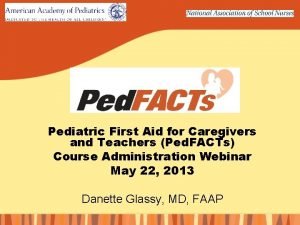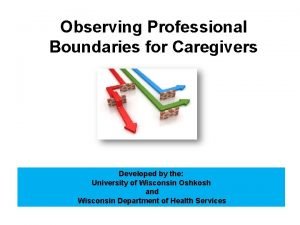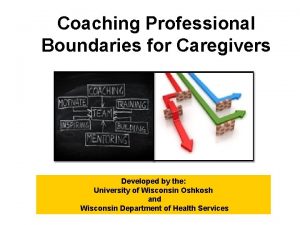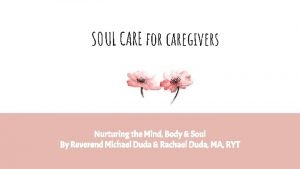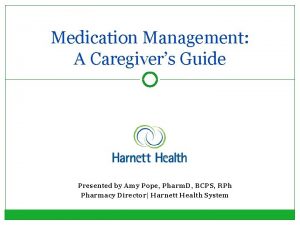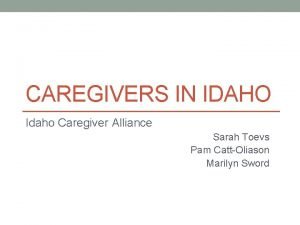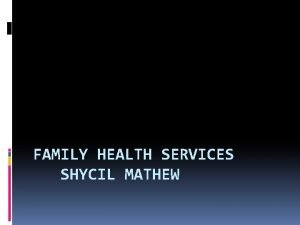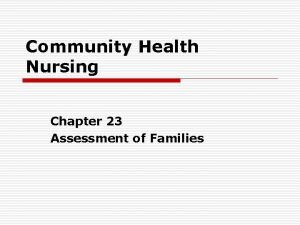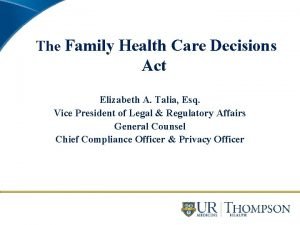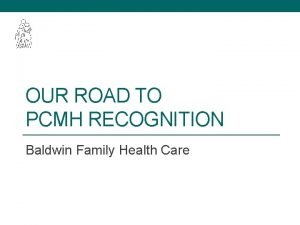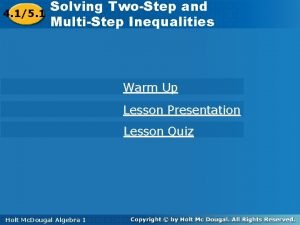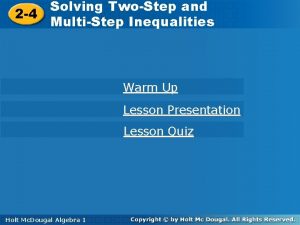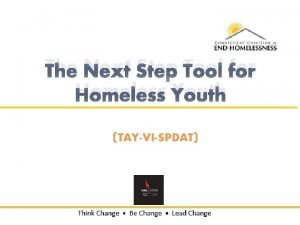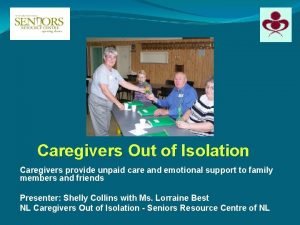Next Step in Care Family Caregivers and Health



















- Slides: 19

Next Step in Care: Family Caregivers and Health Care Professionals Working Together Wednesday, April 30, 2014 Family Caregiving Summit Carol Levine Director, Families and Health Care Project United Hospital Fund

The idealized patient… and a reality check Manages alone… Needs assistance © 2014 United Hospital Fund

Who’s missing? The family caregiver. © 2014 United Hospital Fund

Family caregivers are important to transitions (and readmissions) Many transition plans assume a considerable amount of family care. • The patients most at risk of readmission are often too sick, cognitively impaired, or otherwise unable to “self-manage. ” • The best-laid transition plans will fall apart if one key partner —the family caregiver—cannot do the job. • If family caregivers are not involved in planning, they may not understand what is expected of them; • Family caregivers also have no opportunity to have barriers accounted for in the care plan or to refuse. BUT… © 2014 United Hospital Fund

Family caregivers are poorly integrated in the health system • Providers don’t have a systematic way of identifying family caregivers or including contact information in EHRs. • Family caregiver role is assigned by default, rather than to the person actually doing the job. • “HIPAA” is often INCORRECTLY cited as a barrier to sharing information with family caregivers. • Family caregivers are not routinely included in planning care transitions, nor are their needs and abilities considered when creating care and discharge plans, • The “system” is hard to navigate without guidance. © 2014 United Hospital Fund

Home Alone: Family Caregivers Providing Complex Chronic Care Almost half of all the family members, friends, and neighbors that care for individuals who are seriously or chronically ill do some or all of the following: • Perform medical/nursing tasks such as medication management and administration, injections, wound care, operate medical equipment, and prepare food for special diets. • Care Coordination • Household chores, paying bills • Manage transportation to medical care and community supports • Provide emotional support Source: Home Alone: Family Caregivers Providing Complex Chronic Care by: Susan C. Reinhard, RN, Ph. D, FAAN, Senior Vice President and Director, AARP. Carol Levine, MA, Director, Families and Health Care Project, United Hospital Fund & Sarah Samis, MPA, Senior Health Policy Analyst, United Hospital Fund; AARP Public Policy Institute, October, 2012 © 2014 United Hospital Fund

A shift in responsibility to family caregivers • Performing medical/nursing tasks may prevent nursing home placement, but • Training for family caregivers is limited. • Most care recipients do not receive home visits by health professionals; and • FC quality of life is affected – did I/ will I make a mistake? but… • Family caregivers feel they have no choice. © 2014 United Hospital Fund

Where we want to be… Image: National Quality Forum PFE Action Team 2014 Word Cloud © 2014 United Hospital Fund

How can we change practice? Next Step in Care Focus: • Seriously and chronically ill patients whose family caregivers are significantly involved in their care • Transitions to and from hospitals, nursing homes, certified home health agencies, and hospices Goals: • Provide information and tools to family caregivers to enable them to manage transitions in cooperation with health care professionals • Change provider practice so that family caregivers are routinely included in transition care planning, implementation, and follow-up. Transform the abrupt admission/discharge processes into transitions in care © 2014 United Hospital Fund

www. nextstepincare. org

Next Step in Care • Launched in 2009 • 28 family caregiver guides • All in English, Spanish, Chinese, Russian • Videos • 6 on medication management with CMS, 6 on dementia, 2 on palliative care, 1 awareness, 1 training on using Next Step in Care to support family caregivers • 11 guides for health care providers Additional features: • Guide on how to use website • Glossary • Quality improvement surveys for different settings • Links and resources 11

How can Next Step in Care help YOU? • Free! No agenda, no pitch. • Focuses conversation with family caregiver • Guides cover major areas that need to be discussed, such as • • What Do I Need as a Family Caregiver HIPAA Getting a Post-Discharge Appointment in 7 Days Medication Management • Up-to-date, accurate, and bias-free information • Downloadable, printable tools • A resource you can use TOMORROW © 2014 United Hospital Fund

Family caregiver guides © 2014 United Hospital Fund

© 2014 United H

Providers: Guides at your fingertips • Topics include: • Identification and needs assessment of family caregivers • HIPAA • Medication education • Discharge options and planning • Referrals to community-based services • ED use, urgent care center use • Much more! © 2014 United Hospital Fund

Provider guides © 2014 United Hospital Fund

© 2014 United Hospital Fund

Remember: take away the family caregiver and the structure falls down © 2014 United Hospital Fund

Thank you Carol Levine clevine@uhfnyc. org www. nextstepincare. org © 2014 United Hospital Fund
 Step 1 step 2 step 3 step 4
Step 1 step 2 step 3 step 4 X.next = x.next.next
X.next = x.next.next Health and social care component 3
Health and social care component 3 Pediatric first aid for caregivers
Pediatric first aid for caregivers Unit 2 equality diversity and rights
Unit 2 equality diversity and rights Primary secondary tertiary health care
Primary secondary tertiary health care And now the next step cartoon analysis
And now the next step cartoon analysis Professional boundaries for in home caregivers
Professional boundaries for in home caregivers Coaching professional boundaries for caregivers
Coaching professional boundaries for caregivers Vagus nerve theory
Vagus nerve theory Caregivers guide to medication
Caregivers guide to medication Idaho family caregiver conference
Idaho family caregiver conference Principles of family health services
Principles of family health services Family care plan in community health nursing
Family care plan in community health nursing Fhcda
Fhcda Every system is designed to get the results it gets
Every system is designed to get the results it gets 4-4 graphing sine and cosine functions
4-4 graphing sine and cosine functions Two step linear inequalities
Two step linear inequalities Solving 2 step inequalities
Solving 2 step inequalities Next step tool
Next step tool



